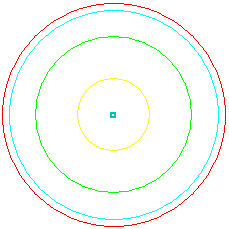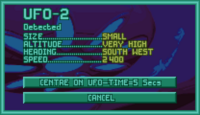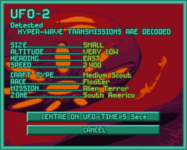Difference between revisions of "UFO Detection"
(Added detection screens for Danial.) |
(Updates including Seb76's deductions from game files and possible 600nm range for craft; Alien Base detection; using graphs) |
||
| Line 5: | Line 5: | ||
Three types of UFO detectors can be built on your bases: | Three types of UFO detectors can be built on your bases: | ||
| − | *[[Small Radar]]s have a range of 300 nautical miles (nm) according to the [[UFOpaedia]]. However, this figure is too short by a factor of five. The Official Strategy Guide gives the figure as 1500 nm, which matches what has been | + | *[[Small Radar]]s have a range of 300 nautical miles (nm) according to the [[UFOpaedia]]. However, this figure is too short by a factor of five. The Official Strategy Guide gives the figure as 1500 nm, which matches game files and what has been observed in-game. |
*[[Large Radar]]s have a detection range of 450 nm according to the UFOpaedia; their actual range is 2250 nm. Large radars cover 225% the total area of small radars (1.5x radius translates into 2.25x area). | *[[Large Radar]]s have a detection range of 450 nm according to the UFOpaedia; their actual range is 2250 nm. Large radars cover 225% the total area of small radars (1.5x radius translates into 2.25x area). | ||
| − | *[[Hyper-Wave Decoder]]s do not have a detection range listed in the UFOpaedia, but | + | *[[Hyper-Wave Decoder]]s do not have a detection range listed in the UFOpaedia, but the OSG, observation and game files show that they have a range of 2400 nm, slightly larger than that of a Large Radar. |
| − | |||
| − | Your first base starts out with a Small Radar; you can choose to add a Large Radar as well, which will take 25 days to build. Both radar types can also be added to any other base you establish. Hyper-Wave Decoders can only be built after you have captured an alien Navigator. [[Research]]ing the navigator unlocks a "Hyper-Wave Decoder" topic; after it is researched, you can build Hyper-Wave Decoders at any of your bases. | + | Additionally, all [[Craft|X-COM Craft]] have a detection range of between 600 nm (deduced from the game files) or 700 nm - 750 nm (from reported observations). Aircraft can be used to search areas remote from your bases, or as a stop-gap while radar is being built. |
| + | |||
| + | Your first base starts out with a Small Radar; you can choose to add a Large Radar as well, which will take 25 days to build. Both radar types can also be added to any other base you establish. Due to a [[Known_bugs|bug]] in the game, additional Radars at the same base have no additional effect on detection. | ||
| + | |||
| + | Hyper-Wave Decoders can only be built after you have captured an alien Navigator. [[Research]]ing the navigator unlocks a "Hyper-Wave Decoder" topic; after it is researched, you can build Hyper-Wave Decoders at any of your bases. | ||
===Detection Ranges=== | ===Detection Ranges=== | ||
| Line 17: | Line 20: | ||
[[Image:Detection and tracking ranges.png]] | [[Image:Detection and tracking ranges.png]] | ||
| − | *Yellow = Detection range of X-COM craft (1500nm diameter) | + | *Yellow = Detection range of X-COM craft (assuming 1500nm diameter) |
*Green = Detection range of a Small Radar (3000nm diameter), also maximum "base detection" range for craft | *Green = Detection range of a Small Radar (3000nm diameter), also maximum "base detection" range for craft | ||
*Blue = Detection range of a Large Radar (4500nm diameter) | *Blue = Detection range of a Large Radar (4500nm diameter) | ||
*Red = Detection range of a Hyper-Wave Decoder (4800nm diameter) | *Red = Detection range of a Hyper-Wave Decoder (4800nm diameter) | ||
| − | In practice, alien craft will often travel well within the listed detection ranges before being spotted. Detection "checks" are only performed twice an hour by the game, so fast-moving UFOs may travel quite a distance before the next check is performed; the Small and Large Radars have only a 10-20% chance of detecting UFOs in-range; and UFOs are not seen until they enter the Earth's atmosphere, which can potentially occur right near a base. | + | In practice, alien craft will often travel well within the listed detection ranges before being spotted by radar. Detection "checks" are only performed twice an hour by the game, so fast-moving UFOs may travel quite a distance before the next check is performed; the Small and Large Radars have only a 10-20% chance of detecting UFOs in-range; and UFOs are not seen until they enter the Earth's atmosphere, which can potentially occur right near a base. X-COM Craft, like the Hyper-Wave Decoder, appear to have a 100% chance of detecting UFOs that are within their detection range. |
Once detected, UFOs remain visible until they leave the Earth's atmosphere or travel outside the detection radius of all available radars. The half-hour check for detection applies to UFO tracking as well, so UFOs may travel far outside your radar coverage before disappearing from the screen. This is especially true for fast-moving UFOs, which can travel as much as 2500 nm between updates. However, a UFO that leaves the atmosphere will disappear immediately. | Once detected, UFOs remain visible until they leave the Earth's atmosphere or travel outside the detection radius of all available radars. The half-hour check for detection applies to UFO tracking as well, so UFOs may travel far outside your radar coverage before disappearing from the screen. This is especially true for fast-moving UFOs, which can travel as much as 2500 nm between updates. However, a UFO that leaves the atmosphere will disappear immediately. | ||
| + | |||
| + | Alien Bases can only be detected by airborne X-COM aircraft (or sometimes by X-COM agent reports at the end of each month). The maximum detection range is 1500nm from the aircraft and the chance of detection appears to decrease with distance. | ||
====Radar Range Overlay==== | ====Radar Range Overlay==== | ||
| Line 31: | Line 36: | ||
[[Image:Range overlays.png]] | [[Image:Range overlays.png]] | ||
| + | |||
| + | == Alien Activity Graphs == | ||
| + | |||
| + | These in-game graphs, accessed from the GeoScape, can be used to suggest the regions and countries where aliens are currently active. Governments and concerned citizens provide this data which is collated and analysed by X-COM. Look for any non-zero activity, but particularly for peaks in the graph and higher values that other regions/countries. Aircraft can then be sent to these areas to confirm alien activity by detecting the UFOs. Be aware that alien mission priorities can change from one month to the next, so be sure you use current data. | ||
== How Radars Function == | == How Radars Function == | ||
Revision as of 17:47, 9 March 2008
Alien craft regularly enter and leave the Earth's atmosphere. In order to prevent them from carrying out their missions, you shoot them down or assault them while landed. However, in order to perform either of these tasks, you must first spot them, which requires some types of UFO Detection equipment, either in your bases or using your craft radar.
Detection Facilities
Three types of UFO detectors can be built on your bases:
- Small Radars have a range of 300 nautical miles (nm) according to the UFOpaedia. However, this figure is too short by a factor of five. The Official Strategy Guide gives the figure as 1500 nm, which matches game files and what has been observed in-game.
- Large Radars have a detection range of 450 nm according to the UFOpaedia; their actual range is 2250 nm. Large radars cover 225% the total area of small radars (1.5x radius translates into 2.25x area).
- Hyper-Wave Decoders do not have a detection range listed in the UFOpaedia, but the OSG, observation and game files show that they have a range of 2400 nm, slightly larger than that of a Large Radar.
Additionally, all X-COM Craft have a detection range of between 600 nm (deduced from the game files) or 700 nm - 750 nm (from reported observations). Aircraft can be used to search areas remote from your bases, or as a stop-gap while radar is being built.
Your first base starts out with a Small Radar; you can choose to add a Large Radar as well, which will take 25 days to build. Both radar types can also be added to any other base you establish. Due to a bug in the game, additional Radars at the same base have no additional effect on detection.
Hyper-Wave Decoders can only be built after you have captured an alien Navigator. Researching the navigator unlocks a "Hyper-Wave Decoder" topic; after it is researched, you can build Hyper-Wave Decoders at any of your bases.
Detection Ranges
The following graphic shows the range of each type of radar system:
- Yellow = Detection range of X-COM craft (assuming 1500nm diameter)
- Green = Detection range of a Small Radar (3000nm diameter), also maximum "base detection" range for craft
- Blue = Detection range of a Large Radar (4500nm diameter)
- Red = Detection range of a Hyper-Wave Decoder (4800nm diameter)
In practice, alien craft will often travel well within the listed detection ranges before being spotted by radar. Detection "checks" are only performed twice an hour by the game, so fast-moving UFOs may travel quite a distance before the next check is performed; the Small and Large Radars have only a 10-20% chance of detecting UFOs in-range; and UFOs are not seen until they enter the Earth's atmosphere, which can potentially occur right near a base. X-COM Craft, like the Hyper-Wave Decoder, appear to have a 100% chance of detecting UFOs that are within their detection range.
Once detected, UFOs remain visible until they leave the Earth's atmosphere or travel outside the detection radius of all available radars. The half-hour check for detection applies to UFO tracking as well, so UFOs may travel far outside your radar coverage before disappearing from the screen. This is especially true for fast-moving UFOs, which can travel as much as 2500 nm between updates. However, a UFO that leaves the atmosphere will disappear immediately.
Alien Bases can only be detected by airborne X-COM aircraft (or sometimes by X-COM agent reports at the end of each month). The maximum detection range is 1500nm from the aircraft and the chance of detection appears to decrease with distance.
Radar Range Overlay
The following graphic can be used to help decide where you would like to site your bases (and therefore, your radars). Ensure you have centred the globe on where you are considering placing a base, then export a screenshot from within the game (using the F12 key) and copy this image over its center to see which areas are included within each radar's detection radius. (This graphic is calibrated for screenshots which are doubled in size (640x400)):
Alien Activity Graphs
These in-game graphs, accessed from the GeoScape, can be used to suggest the regions and countries where aliens are currently active. Governments and concerned citizens provide this data which is collated and analysed by X-COM. Look for any non-zero activity, but particularly for peaks in the graph and higher values that other regions/countries. Aircraft can then be sent to these areas to confirm alien activity by detecting the UFOs. Be aware that alien mission priorities can change from one month to the next, so be sure you use current data.
How Radars Function
Each radar type has a chance to detect any UFO within its range. Detections are performed in the game every 30 minutes exactly on the half hour. (If you are advancing the game an hour or day at a time, you may find the clock jumps forward to exactly a half hour interval whenever it spots a new UFO.)
Small Radars have a 10% chance of detecting UFOs within their range, and Large Radars have a 20% chance. If you have both Small and Large Radars built at the same base, their abilities are added together: you will have a 30% chance of detecting UFOs within 1500 nm and a 20% chance of detecting UFOs from 1500 nm to 2250 nm.
Despite the "Short Range" and "Long Range" detection bars displayed on each base's Information screen, only one radar of each type will be used at each base; building additional radars will have no effect.
Hyper-Wave Decoders have a 100% chance of detecting any UFOs within their range. Given their superior range and detection abilities, Hyper-Wave Decoders make the other radar types unnecessary. If you have Small or Large Radars in a base which also has a decoder, you can dismantle them.
"Normal" radars reveal the approximate size, altitude, heading, and speed of UFOs within range. Hyper-Wave Decoders display the exact craft type, the alien race onboard, what type of mission the UFO is on, and where the mission is to be performed.
Craft-based UFO Detection
All airborne X-COM craft, whether en route or patrolling, can also detect UFOs within a small range, which testing has shown to be 700 to 750 nm. Within this range, craft can detect UFOs 100% of the time. However, given the half-hour detection update intervals and both UFO and craft speed, UFOs can often pass within range of an X-COM craft without being spotted. All types of craft, whether Skyrangers or Avengers, have the same detection radius. Faster craft may sometimes appear to have a shorter detection radius, as they can travel great distances between detection updates, so they often only detect UFOs when right on top of them, or even having passed them already.
If an alien vessel moves out of range of your land-based detection systems, you may be able to resume tracking by sending one of your ships to where you believe the UFO to be (based on its speed and direction).
Alien Base Detection
All X-COM craft are also capable of detecting alien bases. In fact, this is the only way to discover alien bases: they will not show up on any base radar, including Hyper-Wave Decoders. (However, "X-COM agents" will sometimes report the discovery of a base during X-COM's Monthly Report; see Locating an Alien Base.) In order to discover an alien base, an X-COM craft must patrol within 1500 nm of the base's location. The nearer the craft, the sooner the base will be discovered. Patrolling immediately above a base will reveal it almost immediately; patrolling 1500 nm away, the base may take one hour to discover, or several hours.
Bases can only be discovered by patrolling craft. An X-COM craft could fly over an alien base repeatedly and never discover it until it began patrolling in the area.
It is frequently possible to deduce where an alien base is by the pattern of UFO traffic. The primary mission of Supply Ships is to supply alien bases; wherever they land, a base is likely to be found. When a base is first being built, four UFOs (a scout, two supply ships, and a battleship) will converge upon the same area and mill around for a while. (UFOs engaged in an Infiltration mission will display similar behavior involving five ships.) The alien race found at a base will always be of the same type as the race found on the initial ships (or the supply ships which subsequently show up at regular intervals).
UFO Activity Graph
Finally, the UFO activity graphs can act as a sort of "MUFON" (a civilian group dedicated to the observation of UFOs), allowing you to see activity that your radars cannot. The graphs are updated every 30 minutes, on the half hour. You could even check the graphs every so often and build zero radars if you wanted, and if you see a blip, send aircraft. This worldwide coverage can be easily used this way for the first few months. After that, UFO activity becomes too intense and the graphs lose their resolution, but by that time you should aim to have decoders already built, or on the way.
The graph is of particular use for discovering where alien bases have been built; these locations always show a very high degree of alien activity. Note that these graphs are actually showing the aliens' score; this is why even later in the game it will be possible to see where the aliens are being able to complete missions, even if individual UFO flight plans will be swamped.
No matter how wide or powerful your radar network eventually becomes, if you ever find yourself going through any quiet lengths of time where little to no UFO activity is picked up, you should make a habit of checking the graphs. Though they will not provide you with exact locations, you will still get a good indication of the region that needs to be patrolled.


